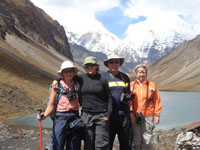Trekking in Bhutan
The power and beauty of the mountains is more impressive on foot than from any vehicle. Whether you take a two-night trek around the Bumthang valley or walk for three days from Thimphu to Paro or take the eight-day trek to the base of Mount Jhomolhari, the views, villages, people and experience will be unparalleled. Whether you take a two-night trek around the Bumthang valley or walk for three days from Thimphu to Paro or take the eight-day trek to the base of Mount Jhomolhari, the views, villages, people and experience will be unparalleled.
Awakening at dawn to the sound of the cockerel and a warming mug of tea, trekkers at higher altitudes are invariably greeted by breath-taking vistas. Few sites on earth can equal the first sunlight hitting a Himalayan mountain. Trekking during April and May in the Himalayas brings the deep reds and oranges of the rhododendron blossom.
Physical Fitness
Treks vary from short three-day walks across low altitudes to the three-week Snowman Trek that covers 356 kilometres and climbs three of the Kingdom’s highest passes. Not only the overall duration but also the daily walking distances vary substantially according to the different trek routes.
Route Characteristics:
Snowman Trek – is said to be the hardest trek in the world, with 12 passes between 4500 and 5300 metres, overnight stays at between 3700 und 5100 metres, 24 days, the majority in unsettled, high alpine areas.
Laya Gasa Trek - is the first part of the Snowman Trek, starting from Paro and leaving the Snowman in Laya to descend to Punakha. Requires good endurance and leads up to high passes, one of them above 5000m, 12 – 14 days
Jomolhari Trek, Rodung La Trek – Routes in the high mountains, requiring some endurance, 6 to 10 days depending on the chosen route, partly in unsettled areas.
Druk Path, Dagala Trek, Gasa/Laya Trek – shorter treks with remarkable altitude differences, 3 – 6 days.
Bumthang Culture Trek, Gangtey Trek, Samteygang Trek, Nabji-Korphu Community based Nature Trek – simple routes from village to village, 3 – 4 days.
Bhutan offers all different levels of trekking that will suit your taste and physical fitness. To choose the right trek, see the detailed descriptions of each trek.
Trekking Between Unclimbed Peaks.
Trekking in Bhutan involves walking along routes passing by 7000 metre high mountains. Such peaks are permanently covered in snow and remain unclimbed even today. Mountaineering is forbidden in Bhutan due to the Buddhist belief that all mountains are representations of holy deities and should therefore not be exposed to the disruption of mountain expeditions.
Guiding, Food and Camping
In Bhutan, all trekking supplies – camping equipment, kitchen implements, food – are all carried on animal back (ponies). Porters are rather unusual in Bhutan with loads usually carted by horses or, in higher regions, yaks. All trekkers are accompanied by a guide, a cook and usually at least one horseman or yak herder. With the surest footing; they lead trekking groups across the passes. The horseman and cook will usually run ahead during a trekking day. They will have prepared a packed lunch for hikers and will go on to the night’s resting place to set up camp.
They set up tents, cook dinner and ready the area for arriving trekkers. When trekkers reach the campsite they are greeted with a hot cup of tea and biscuits in the dining tent. After six hours on the mountains, no drink will ever taste sweeter. For dinner the cook will usually prepare a buffet of dishes that are as welcome as they are delicious.
When to Trek
For walkers the most appropriate trekking times are mid-March to mid-May and mid-September to the beginning of November. There are however also trekking routes that are better suited to Summer or Winter. Earlier in the year the light is sharper but the nights are very cold. In autumn, after the rainy season, the skies clear and the leaves begin to turn yellow. Between mid-June and mid-September one should expect regular rainfall. At altitudes beneath 2000 metres leaches can be a challenge. To find the possible and best times for each single trekking route please see the table of trekking routes and the detailed descriptions of each route on our website.

|
